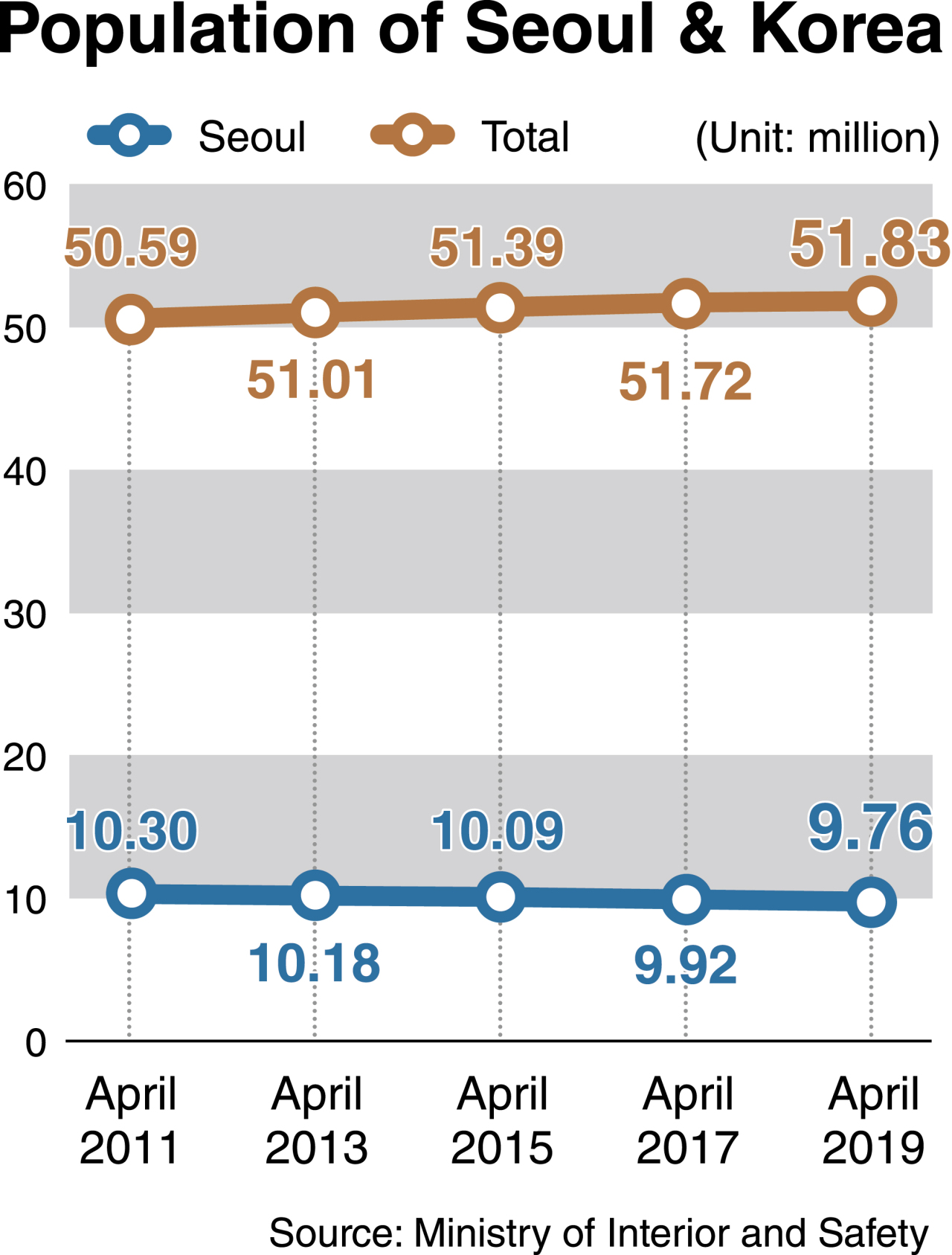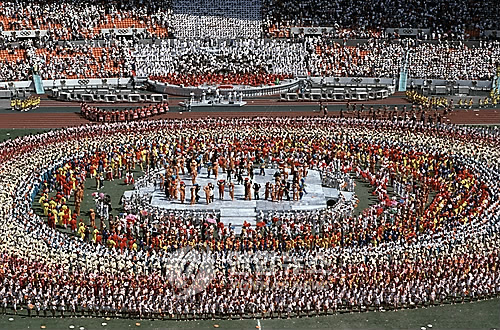[News Focus] Seoul population falls to level of mid-1980s
By Kim Yon-sePublished : May 6, 2019 - 17:29
Over the past eight years, despite sinking fertility rates, South Korea’s population continued to grow. Now decidedly an aged society, the country stands at No. 28 in the global population rankings.
According to the Ministry of Interior and Safety, the population reached 51.83 million as of April 2019, up 0.09 percent from 51.79 million a year earlier.
Since April 2011, when the population was 50.59 million, it has grown 2.45 percent. In other words, the number of Koreans increased 1.24 million.
But the demographics of the nation’s two largest cities, Seoul and Busan, moved in the other direction. During those same years, their collective population decreased 666,000.
According to the Ministry of Interior and Safety, the population reached 51.83 million as of April 2019, up 0.09 percent from 51.79 million a year earlier.
Since April 2011, when the population was 50.59 million, it has grown 2.45 percent. In other words, the number of Koreans increased 1.24 million.
But the demographics of the nation’s two largest cities, Seoul and Busan, moved in the other direction. During those same years, their collective population decreased 666,000.

In April 2011 Seoul had 10.3 million registered residents, but the capital’s population has seen a steady decline since then. It recorded 10.13 million in April 2014, 9.92 million in April 2017, 9.83 million in April 2018 and 9.76 million in April 2019. In May 2016 the number fell below 10 million for the first time in 28 years.
Given unofficial statistics indicating that Seoul was home to 9.2 million in 1983 and 10.28 million in 1988, the current population level is estimated to be similar to that seen in the years from 1984 to 1987. It is believed to have topped 3 million in the 1960s and 7 million in the 1970s, according to a variety of archives.
The Interior Ministry data showed that the population of Seoul declined by 534,000, or 5.19 percent, over the past eight years.
Nevertheless, during the same time frame the number of households in the nation’s largest city increased -- from 4.21 million in April 2011 to 4.29 million in April 2019. This seems to be due to the rapid growth of single-person households.
As of last month, people residing alone comprised 1.71 million of Seoul’s 4.29 million households, or 39.86 percent -- higher than the nationwide average of 37.1 percent.
Seoul’s population sex ratio was the lowest in any part of the country, with 95 male residents for every 100 female residents or 4.76 million males and 4.99 million females.
In addition, over those same eight years the number of male residents in Seoul fell more sharply than the number of female residents with a decline of 6.55 percent, or 334,000 individuals.
Across the nation, women outnumbered men by about 100,000 last month at 25.96 million versus 25.86 million.
A demography researcher in Sejong Autonomous City attributed the decline in Seoul’s population to the exodus of Seoulites to new residential communities that have sprung up in Gyeonggi Province over the past decade.
“In addition, a large portion of civil servants and public firm employees had to give up residing in Seoul” when their workplaces relocated, he said. “Many bought apartments in (the administrative-oriented) Sejong, and (the so-called) innovation cities nationwide.”
Sejong, which was created in July 2012, saw its population shoot up by nearly 200,000 over the past five years -- from 128,200 in April 2014 to 324,417 in April 2019.
In just the past year, the number of residents in the self-governing city has increased 9.95 percent, from 295,041 in April 2018.

A research analyst in Seoul identified increased population density in cities in Gyeonggi Province -- for example, Suwon, Goyang and Yongin -- as a newly emerging problem.
While each of the three Gyeonggi cities has more than 1 million residents, the population of Suwon, 1.19 million, surpasses that of Ulsan, one of the nation’s six metropolitan cities, which only has 1.15 million.
“Despite the desirable drop in Seoul’s population, the government has not been successful in resolving the problem of the densely populated Seoul metropolitan area,” he said, referring collectively to Seoul, Gyeonggi Province and Incheon Metropolitan City.
Over the past eight years, the populations of Gyeonggi and Incheon climbed by 1.28 million (10.87 percent) and 184,000 (6.65 percent), respectively, to 13.12 million and 2.95 million.
Increasing population density is also becoming an issue in Gyeonggi’s fourth-largest city, Seongnam, and its fifth-largest city, Bucheon -- home, respectively, to 900,000 and 800,000 residents.
Meanwhile, Busan showed a 3.68 percent population decline -- from 3.56 million registered residents in April 2011 to 3.43 million in April 2019.
Daegu, the nation’s fourth-largest city, was also part of this trend with the number of residents dropping by 2.25 percent to 2.45 million during the same eight-year period.
Among Korea’s provinces, South Gyeongsang Province remained the second-most-populous with 3.36 million residents, trailed by North Gyeongsang Province with 2.67 million and South Chungcheong Province with 2.12 million. Jeju Province occupied the bottom rank with 668,000.
By Kim Yon-se (kys@heraldcorp.com)






![[KH Explains] How should Korea adjust its trade defenses against Chinese EVs?](http://res.heraldm.com/phpwas/restmb_idxmake.php?idx=644&simg=/content/image/2024/04/15/20240415050562_0.jpg&u=20240415144419)











![[Today’s K-pop] Stray Kids to return soon: report](http://res.heraldm.com/phpwas/restmb_idxmake.php?idx=642&simg=/content/image/2024/04/16/20240416050713_0.jpg&u=)